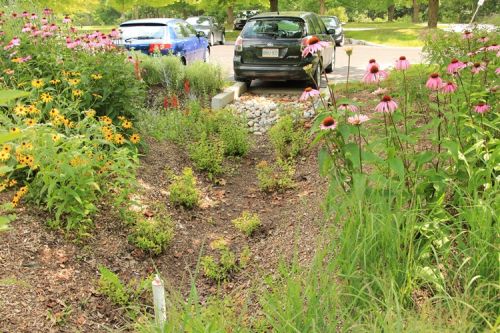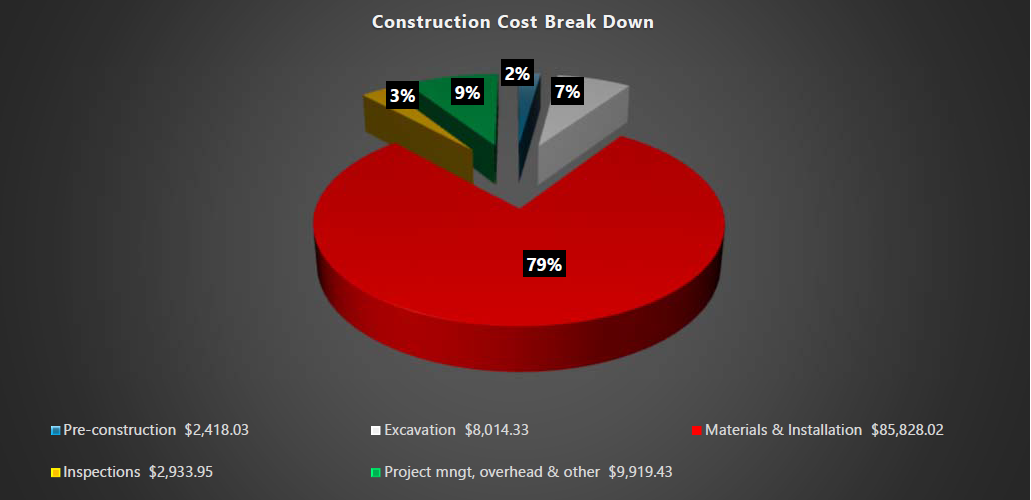Bioretention: Life Cycle Costs

Overview[edit]
Given that Bioretention is a widely used name and a general "catch-all" term for most vegetated LID practices that temporarily store stormwater runoff in depressed planting beds there are a number of configurations of the feature that can be used in various contexts and environments. Depending on native soil infiltration rate and physical constraints, the facility may be designed without an underdrain for full infiltration, with an underdrain for partial infiltration, or with an impermeable liner and underdrain for no infiltration/filtration only (i.e., a stormwater planters or biofilter) design. STEP conducted life cycle costs estimates for each of bioretention's 3 design configurations which can be viewed below. To design your own life cycle cost estimates that can be adapted to fit your project budget and unique development needs access the updated LCCT Tool here.
Design Guidance[edit]
Bioretention is an ideal technology for fitting functional vegetation into urban landscapes and treating runoff collected from nearby impervious surfaces.
Components include: a 'filter bed' with filter media, storage layer of reservoir aggregate, planting and a finishing surface layer of mulch and/or stone.
Additional components include an underdrain to remove excess water and soil additives to enhance pollutant removal.
Tool defaults based on STEP recommendations:
- Maximum drainage area to surface area ratio of 20:1
- Default depth of 0.75 meters.
- Default mulch depth of 75 millimeters.
- An underdrain (minimum 200 mm perforated pipe) is only needed when native soil infiltration is less than 15 mm/hr or infiltration is precluded.
Design Notes[edit]
- Designs include pretreatment through stone diaphragms at curb inlets. Pretreatment through settling forebay and vegetated filter strip not included.
- The tool calculates costs for new designs and includes costs for contractor overhead and profit, material, delivery, labour, equipment (rental, operating and operator costs), hauling and disposal. Mobilization and demobilization costs not included. The tool adds 10% contingency and additional overhead.
- Design and Engineering cost estimates are not calculated by the tool and must be supplied by the user.
- Unit costs are based on 2018 pricing; the tool automatically adds inflation. See the Assumptions sheet in the tool for further details.
- The cost of retrofitting is ~16% higher than the cost of new construction.
- Retrofit costs are included in the 'Costs Summary' section and can be added to the Total Construction Cost for increased accuracy.
- Retrofit costs are included in the 'Costs Summary' section and can be added to the Total Construction Cost for increased accuracy.
Note: Bioretention (all 3 design scenarios): Includes pretreatment sump at inlet and assumes that rehabilitation of filter media bed is performed at 25 years.
Construction Costs[edit]
Above you can find a cost breakdown of a 250m2 non-infiltrating/filtration only Bioretention practice best suited in an urban environment where infiltration into underlying native soils may not be possible due to heavy use of utilities below, contaminated soils, shallow bedrock, and/or Zero-lot-line developments such as condos or dense urban infill.
As can be seen the greatest cost for this practice will be Material & Installation, which include costly components such as the, impermeable membrane/liner appropriate planting and vegetation selection, filter media and the stone storage layer or Internal water storage zone (IWSZ).
Life Cycle Costs[edit]
25-Year life cycle cost break down[edit]
25-Year life cycle cost break down[edit]
Total Cost & Design Summary[edit]
Full Infiltration[edit]
Partial Infiltration[edit]
Non-Infiltrating/filtration only[edit]
References[edit]
- ↑ Performance Comparison of Surface and Underground Stormwater Infiltration Practices TECHNICAL BRIEF. Accessed Dec 12 2022. https://sustainabletechnologies.ca/app/uploads/2016/08/BioVSTrench_TechBrief__July2015.pdf
